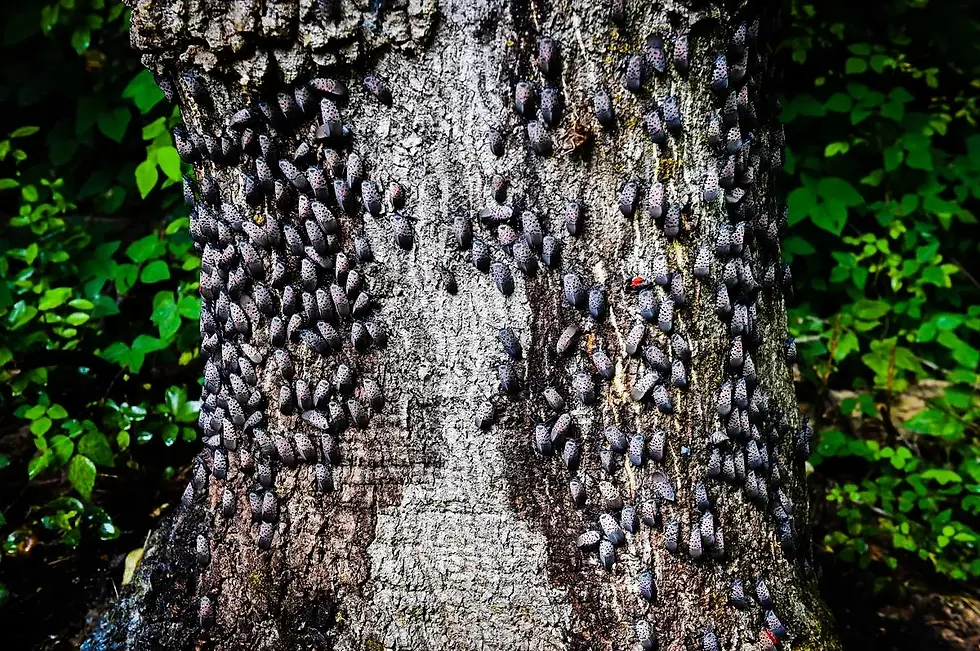Spotted Lanternfly in Illinois: The Role of Tree of Heaven
- John Powell
- Nov 5, 2024
- 2 min read

The Spotted Lanternfly (SLF), a destructive invasive insect from Asia, has alarmingly made its debut in Illinois. Central to their rapid spread and proliferation is an equally invasive tree known as the Tree of Heaven. Here's why Illinois residents should be concerned.
Understanding the Spotted Lanternfly, scientifically known as Lycorma delicatula, is a beautiful yet harmful planthopper. Recognizing them is crucial for effective control, as their presence can harm both local ecosystems and economies. These pests feed on the sap of many native and non-native hardwood trees, and secrete "honeydew" which attracts other pests and causes other types of pathogens in trees and crops.

How Did the Lanternfly Reach Illinois?
Illinois's lush environment has unfortunately become a new home for the SLF. Since its first confirmed sighting on September 26, 2023, as reported by the Chicago Sun-Times, there's been heightened concern and urgency to curb its spread.
Economic and Ecological Threats Posed by the Spotted Lanternfly
Agricultural Damage: SLFs feed on sap from various plants, threatening vital industries in Illinois, such as the grape, apple, soy, and timber businesses.
Environmental Impact: Without natural predators, their unchecked growth harms native species, disrupting the local ecosystem.
Recreational Areas Affected
Natural sites, parks, and gardens are visibly marred by SLF presence, detracting from their beauty and enjoyment. Residential landscapes are not immune, and landscape trees such as pine, oak, maple, cherry, and walnut are all susceptible to their damage.
The Critical Connection: Tree of Heaven and Spotted Lanternfly
The Ailanthus altissima, or Tree of Heaven, plays a pivotal role in the SLF's lifecycle. Originating from China, this tree provides the ideal habitat for the lanternfly, facilitating its spread. As a host plant, and one that is incredibly common now in our state, the flies are attracted to, and reproduce more quickly when this host is available, making other trees and crops more susceptible to their damage.

Why Eradicating the Tree of Heaven is Crucial
Habitat Preference: The SLF prefers the Tree of Heaven for feeding and reproducing. Limiting this tree can curtail their population growth.
Natural Dependency: Their shared origin means the lanternfly is adapted and somewhat reliant on this particular tree.
Rapid Proliferation: Like the SLF, the Tree of Heaven is invasive, spreading quickly and proving challenging to remove.
Proactive Measures: How Illinois is Fighting Back
By combining tree removal strategies with innovative pheromone traps, Illinois hopes to reduce both Tree of Heaven and SLF populations.
If opting for removal, which is the ideal but more expensive route, then always make sure your arborist is trained and experienced in tree removal. Safety of people and property is crucial in ensuring a successful Tree Of Heaven removal. Homeowners looking to preserve their valuable landscapes must be extra diligent in doing everything they can to remove habitat and mitigate populations on their property.
As the Spotted Lanternfly in Illinois emerges as a concerning issue, understanding its symbiotic relationship with the Tree of Heaven is pivotal. Armed with this knowledge, Illinois can strive to protect its diverse landscapes from these invasive threats.



Comentários